How Do You Repair Torn Drywall Paper
How to Repair Torn Drywall Paper
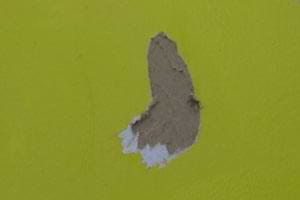
Drywall paper can exist damaged when a wall is gouged while moving furniture or other common household activities. Water tin also damage drywall paper, causing the surface to pucker and ripple. This can happen when removing wallpaper with a liquid stripper or when a leaking pipe or roof allow water to damage walls and ceilings.
The almost of import part of repairing damage like this is sealing it so it doesn't absorb any moisture from the repair compound and touch-up paint. If you don't seal the surface, the repair process volition crusade the undamaged layers of paper to bubble and ripple once again and no amount of sanding will set up the problem. Employ the post-obit process for a trouble-free repair of torn drywall paper and check hither for a video demonstrating how to repair torn drywall paper.
Cut Away the Impairment
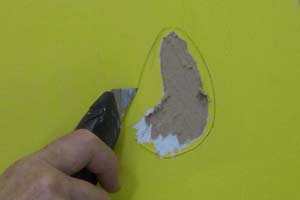
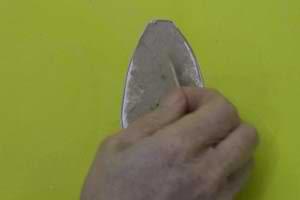
Cut all the torn or puckering paper away from the gypsum. Cut cleanly effectually the perimeter with a precipitous utility pocketknife or a razor blade. Tilt the blade out a little to cut at a slight angle through the paper. Gently skin the crude fringes of loose paper gratis, leaving a polish surface behind.
If only the first few layers of paper are affected, cut downwardly to the showtime undamaged layer. Otherwise, remove all the damaged and peeling paper from the gypsum cadre.
Seal the Drywall Paper
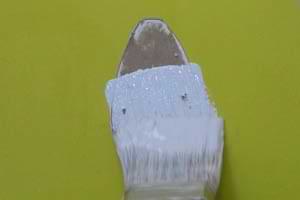
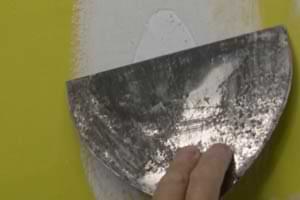
Encompass the exposed gypsum and surrounding wall with a thick glaze of oil or shellac primer-sealer. Stir the sealer or shake the can first to exist sure information technology's mixed well and so employ ii very thick coats with a brush. Allow the primer dry out for virtually an hour between coats and let the terminal coat dry completely before proceeding.
When the second coat of sealer is dry, use a joint knife to smoothen out the raised paper fibers so they don't stick upwardly and interfere with the repair chemical compound. Become over the surface once or twice with the blade in a downward stroke to flatten the fibers out.
Employ a Glaze of Articulation Compound
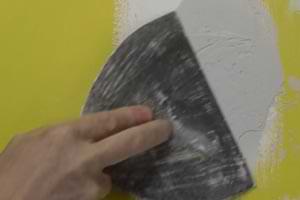
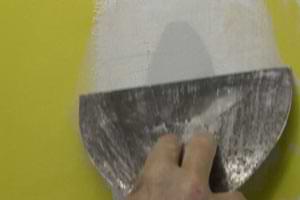
Mix some setting-type joint chemical compound, as well chosen mud, and use information technology to cover the damaged surface area. Apply a thick coat over the damage and surrounding wall. Holding the joint knife at an angle, "butter" the surface with back and forth strokes to leave virtually one/eighth inch coat of mud.
Immediately go back over the area to skim the excess mud from the surface leaving a thin coat covering the harm and surrounding surface area. Hold the pocketknife at a 30° bending and press down hard merely non hard plenty to dig into the surface every bit you skim from one side to the other. Scrape the collected mud from the pocketknife onto the rim of a mud pan with each pass and go over the whole area in parallel strokes.
Ignore any ridges left past the blade edge, these will be removed after the mud has dried. Effectually the perimeter of the repair, skim the mud as thin as possible to blend information technology into the surrounding wall. Let the mud gear up for about 30 minutes or until it has completely hardened.
When the mud has set, shave off any ridges with upward strokes of the pocketknife blade. Follow with medium grit sandpaper to lightly sand the whole patch, smoothing out any other bumps or protrusions. At the edges, sand to feather information technology with the surrounding surface.
Employ a 2nd Coat of Joint Compound
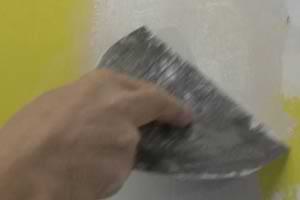
Wipe the sanding dust off with a clammy rag and apply a second coat of mud. Cover with a thick coat and so skim off the excess stroking in the opposite direction from the beginning coat. If you skimmed the first coat vertically, smooth the next with horizontal strokes. This will help to level out an uneven surface in your repair.
Let the mud dry and if necessary, apply another coat to build upwardly the patch, hiding the impairment while also smoothing out the area. As before, shave off any ridges get-go and sand earlier skimming the patch again. With each new coat, stroke in the opposite direction from the previous application.
Sand and Touch Up the Paint
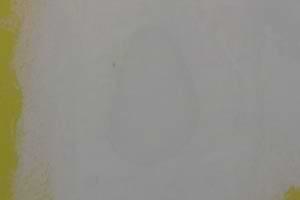
Permit the terminal coat of mud dry well and then sand information technology using calorie-free pressure in wide back and forth strokes to smooth and alloy the surfaces. Along the edges, sand harder to feather the patch with the finished wall surface but avert digging in. Wipe the sanding grit away with a damp rag existence careful not to wipe away the finished patch.
Permit the moisture from the rag dry out and prime the patch. If yous are using apartment latex finish paint, information technology will be self-priming. If yous are using semi-gloss or other shiny paint, prime number with apartment latex paint or a latex primer first before touching up the wall pigment.
- How to Repair Bubbles Paint
- How to Repair Torn Drywall Paper
- Repairing H2o Damaged Drywall
- Repairing Water Damaged Plaster
- Repairing Crumbling Plaster
- Repairing Major Plaster Impairment
- Repairing Wood Board Plaster
- Repairing Drywall Nail Pops
- Repairing Small-scale Wall Holes
- Repairing Large Wall Holes
- Repairing Big Ceiling Holes
- Repairing Small Ceiling Holes
- Repairing Wall and Ceiling Cracks
- Repairing Cracks with Expanding Foam
- Installing a Drywall Ceiling
- Finishing Recessed Drywall Joints
- Finishing Metal Drywall Corner Bead
- Finishing Paper Corner Dewdrop
- Finishing Inside Drywall Corners
- Finishing Drywall Butt Joints
- How to Practise Drywall Texturing
- Skim Coating on Walls and Ceilings
- Sanding Drywall Joint Compound
- Wall Tools and Materials Guide
Source: https://www.do-it-yourself-help.com/repairing-torn-drywall-paper.html
Posted by: bollingermards1966.blogspot.com


0 Response to "How Do You Repair Torn Drywall Paper"
Post a Comment